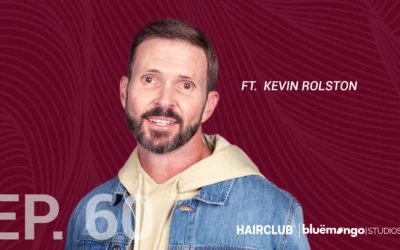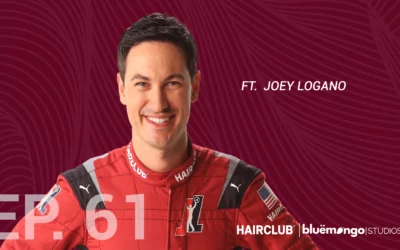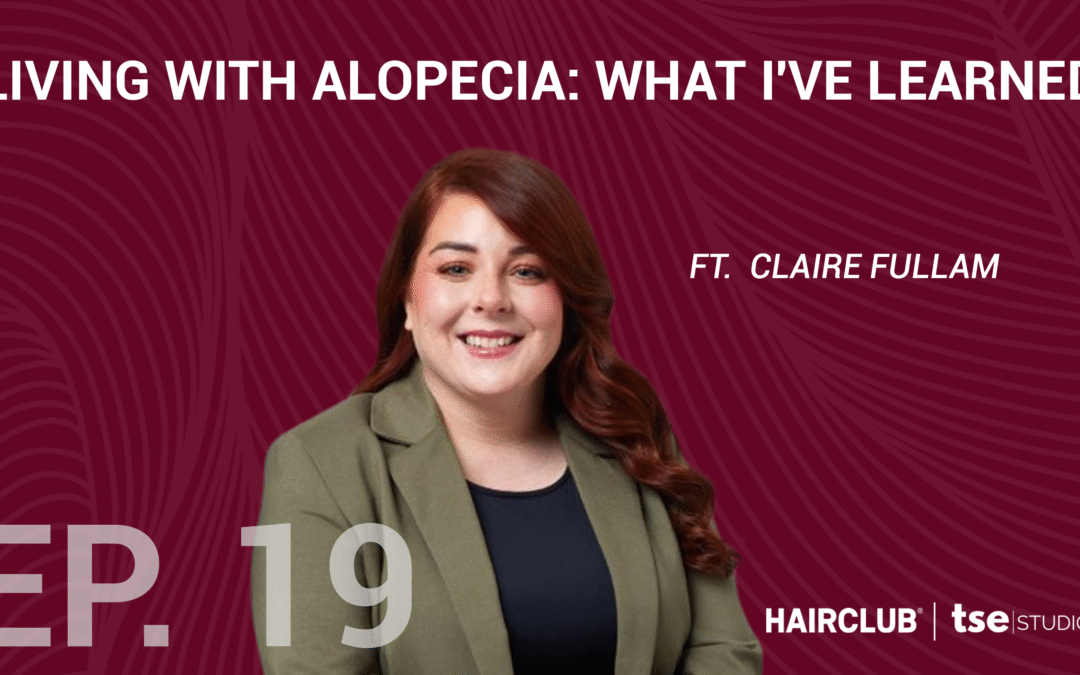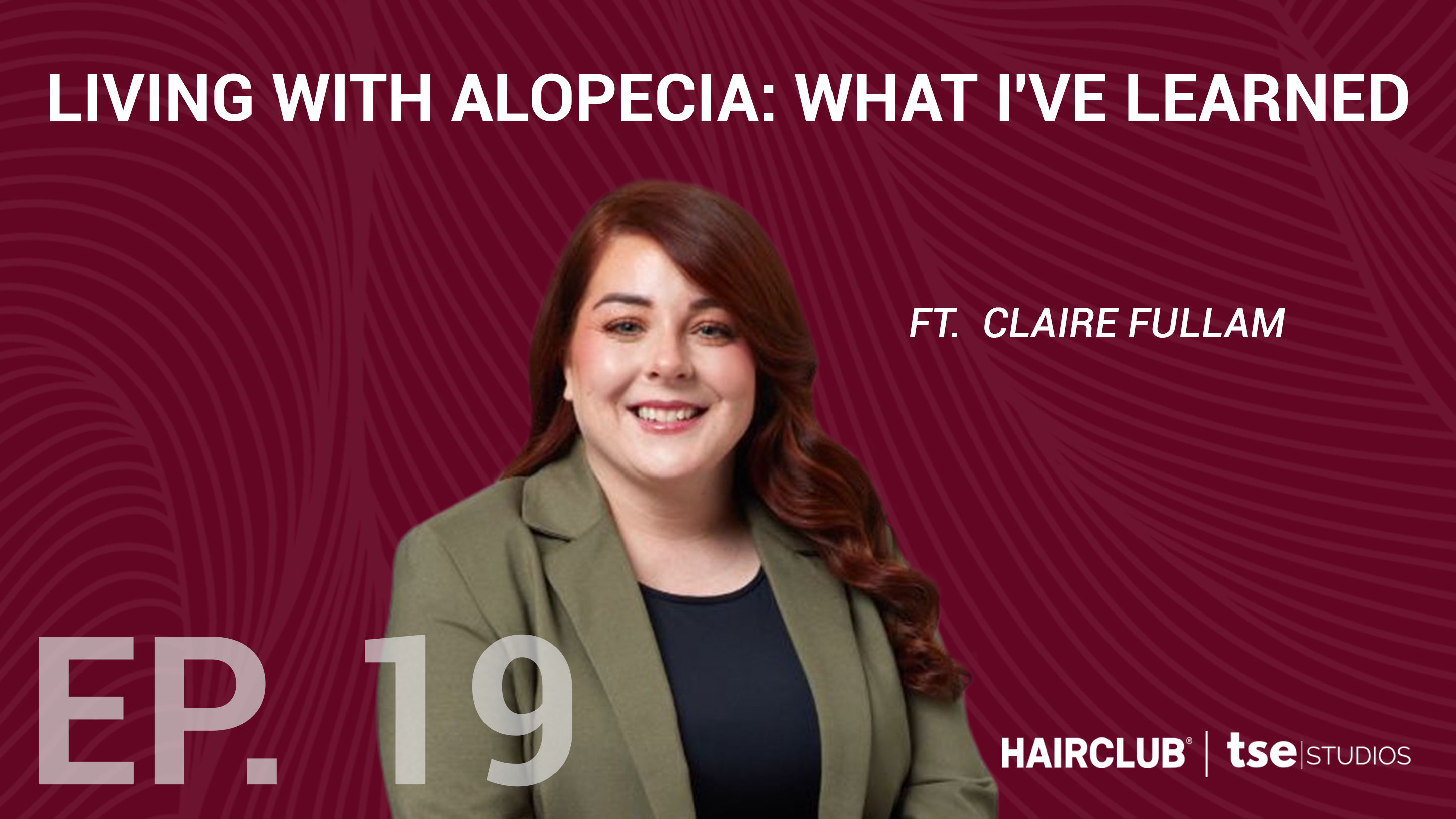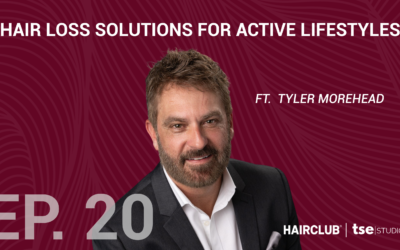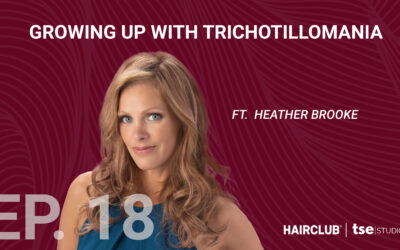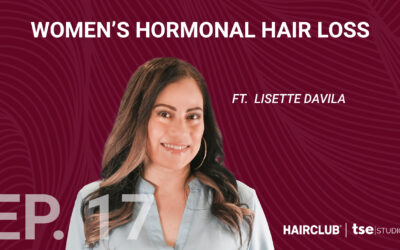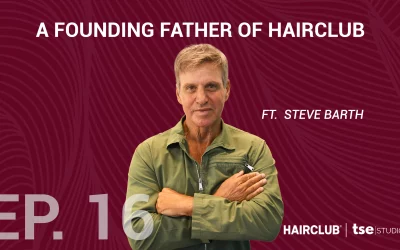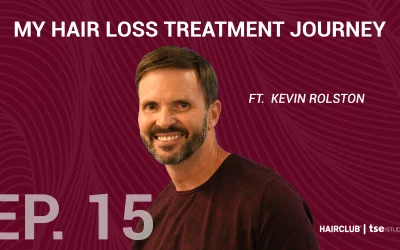Can your fitness routine lead to hair loss? HairPod explores the impact of supplements, testosterone, and stress on hair health this spring.

Laser Hair Therapy Benefits
Episode 42
Laser Hair Therapy Benefits

Laser therapy for hair loss isn’t new. In this episode, I meet with Dr. Phipps to talk about the science behind laser or low-level light therapy (LLLT) and what makes a great candidate for it. We also discussed whether there have been any adverse health effects noticed in people who have used laser therapy for years.
Low-Level Light Therapy for Hair Loss
What is laser therapy for hair loss, and how does it work? Laser therapy, also known as low-level light therapy (LLLT), uses a specific wavelength of light to stimulate the cells of hair follicles. Different delivery methods are available, including caps, helmets, and combs. The light therapy doesn’t cause any discomfort or sensation, which causes some users to think the light isn’t working. Dr. Phipps gives the example of the sun; the sun’s UV rays are able to penetrate the skin and stimulate cells to cause a tan because of the wavelength of those rays. Similarly, a laser device must use specific wavelengths of light to stimulate the skin cells. Typically, cheaper versions of these devices are sold online, so finding a reputable supplier is critical.
How to Use Laser Therapy for Hair Loss
Is laser therapy right for you? Laser therapy works by gently stimulating hair follicle cells, so in situations of relatively recent hair loss or thinning, laser therapy can keep the follicles healthy to produce strong, healthy strands. Each treatment is approximately 8 minutes per day, and much like the sun in the example above, it must be done every day, or the effects will wane (just as your tan will wane if you stop going out in the sun). Stopping laser therapy will cause hair loss to resume at the rate it was happening before LLLT was started.
Are You a Candidate for Laser Therapy?
Hair follicles can die, and once they have died, laser therapy will not bring them back or create new follicles. That’s why it’s important to consult with a hair loss professional to determine if laser therapy will be effective for your type of hair loss or thinning. As mentioned before, it also requires consistent use, so take that into consideration as you weigh your options. Laser therapy devices can be purchased for home use, as they are safe, durable, and easy to apply. Quality laser therapy devices can last a long time – Dr. Phipps shares that her father has been using the same laser cap for ten years.
Empowering Resources
As the episode draws to a close, HairPod extends a generous offer of a complimentary hair loss consultation, providing a tangible step towards reclaiming confidence and control over one’s appearance.
Book a free consultation with HairClub Today! Thanks for listening to HairPod. We hope you enjoyed this episode. If you did, please leave us a rating or review wherever you get your podcasts. If you’d like to connect with us on social media to share your story, check us out on Instagram @HairClub. HairPod is a production of TSE Studios. Our theme music is from SoundStripe.
Episode.42 Transcript
Dr. Angie Phipps [00:00:02]:
I would recommend if you have a family history of hair loss, and you know this may be coming down the pike, go ahead and get on it. Anybody over the age of 40 is gonna have age-related hair shaft diameter thinning that I would recommend stimulating those cells with the light, but it’s gonna be most beneficial from a cosmetic standpoint for individuals who are in the early phases of hair loss who have generalized diffuse thinning, because if you’ve already developed a bald spot, the bald spot is not gonna go away with light therapy.
Kevin Rolston [00:00:45]: Welcome to HairPod, the podcast where you get to hear real people talk about their hair journeys. I’m your host Kevin Rolston, and each week I get to interview people from different walks of life whose lives have been touched by hair loss in some form or fashion. Many of our guests have experienced hair loss themselves and found a way to get their confidence and their hair back.
Today we’re gonna be diving into a topic that may have come across while scrolling social media or maybe you’ve just seen it when searching for effective ways of getting your hair back. This week we’re gonna be talking about laser hair therapy for hair loss, also known as low-level light therapy. It’s been making waves in the hair restoration world for years, and today we’re gonna get into the science behind it to learn whether it works, why it works, and who it works best on.
Picture this, a device that looks like a high-tech cap or a sleek handheld comb, emitting gentle red light that penetrates your scalp. There’s no pain, no heat, just light. This cutting-edge technology uses safe, low-intensity lasers to stimulate hair follicles, which can improve your hair health and growth.
You may be wondering, does it really work? Or is this just another flashy trend? And who better to help us answer those questions than hair transplant surgeon and star of TLC’s Bad Hair Day, Dr. Angie Phipps. She’s back on HairPod today to help us break all of this down.
Dr. Angie Phipps [00:02:17]: I’m glad to be talking about this topic because it’s in the forefront of all things TikTok, Instagram, and all that. So we need to educate people about it.
Kevin Rolston [00:02:28]:
I see so many posts on social media about these things, and of course they make them look absolutely amazing. And having been through it myself, when I don’t share the same experiences that you see on Instagram and TikTok, it really makes me skeptical. Now my question for people that don’t know and maybe haven’t seen the ads that are on Instagram and TikTok and the social media sites, what exactly is a laser therapy and how does it work at a scientific level?
Dr. Angie Phipps [00:02:56]: So it’s actually what I like to call low-level light therapy. So light wavelengths can penetrate different depths of tissues. And so they use blue light for certain skin conditions, there’s green light, there’s purple lights, and the red light that we use in the either LED or in what they call laser therapy is a particular wavelength that will penetrate the skin to reach the level of where the hair follicle root or cells are located.
And what it does is that photobiochemically stimulates those hair follicle cells to function at a higher energy capacity. And if your hair follicle cells are functioning at a higher energy capacity, number one, they live longer, which we want to fight the effects of aging. So I highly recommend it for anybody over the age of 40 really just to help prevent the hair follicle width or diameter from shrinking at the current aging rate that it is.
And then number two, it helps to allow the cells to produce a hair shaft that can be as thick as possible. And a thicker hair shaft covers more scalp surface area than a skinny hair shaft. Now this light therapy is not magic.
It’s not going to regrow a new hair follicle that you don’t have. So a lot of times on these social media websites or on the internet or on TV, they make people think or consumers think that they’re going to buy this magic helmet, hat, comb device, and it’s going to grow back all their hair. And that’s misleading because what it does is it can only stimulate the hair follicle cells that are currently in your head.
Now, where they can get away with saying it can stimulate or generate regrowth is sometimes you have hair follicle cells that are in follicles that are alive. They’re just so weak that they can’t make a hair that is actually strong enough to exit the skin of the scalp. So with this photo biomodulation with the light therapy, it can maybe strengthen those cells so that the hair that is still capable of producing can actually exit the scalp so that you can now see it.
So you do see regrowth of hair shafts, but it’s not growing a brand new hair follicle. And if that hair follicle is dead and gone and the cells are dead, you can’t re-alive it with light therapy or with any therapy actually.
Kevin Rolston [00:05:14]: So when it’s gone, it’s gone.
Dr. Angie Phipps [00:05:16]:
When it’s gone, it’s gone. And a lot of people think light therapy is hocus pocus because when you apply these devices to your scalp, it’s not hot, it’s not cold, it doesn’t jiggle, it doesn’t wiggle, it’s not, doesn’t hurt, it doesn’t feel good. And you just think I’m just sitting here with this light on my head and it’s not doing anything.
But that’s not true. It is doing something. If it’s at the right wavelength, it is penetrating the skin and stimulating the cells.
And I explain it to my patients like this. If you go out into the sun, the wavelength of the UV rays of the sun will penetrate your skin and stimulate melanocytes or pigment producing cells in the skin and you’ll get a tan or it produce color. Did you feel it?
No. Did it happen? Yes.
And then if you want to keep that stimulation to continue to produce the pigment, you go back out into the sun every day to re-stimulate those pigment producing cells with the UV rays of the sun and you keep your tan. If you stop going back out into the sun, the pigment producing cells stop producing the pigment and the tan goes away. So the same thing with a low level light therapy.
This needs to be used on a daily basis to keep the hair follicle cells stimulated, to keep them at the energy capacity that allows them to have their longest life and produce the thickest hairs possible. So it is a daily therapy and it does do what it’s supposed to do, but it’s not going to be something that’s going to grow a full head of hair, but it is going to be part of a maintenance therapy that will in the long run help your hair follicle cells immensely.
Kevin Rolston [00:06:38]:
How long would you need to do this every single day?
Dr. Angie Phipps [00:06:40]: Usually eight minutes a day. And you’re going to do something for eight minutes a day. My family members, you know, before we go to bed, we watch a TV show.
So, you know, when ESPN comes on, the hat goes on. Or when Real Housewives from Beverly Hills comes on, my hat goes on. Or if you’re going to scroll through TikTok or Instagram or Facebook or whatever, just put your hat on and be done with it.
Kevin Rolston [00:07:06] Dr. Phipps shared some great insights into the science behind laser therapy and the importance of consistency. Doing it every day really does make a difference. The steady commitment is the key to achieving visible results over time.
When you know how it works, it can help you set the right kinds of expectations if this is a treatment that you’re interested in pursuing. Yes, laser therapy can help regrow your hair. But if you’re hoping for dramatic results after one or two treatments, you’re probably going to feel disappointed.
The key to laser therapy is consistency. It’s got me wondering what kinds of tools are out there for laser therapy and whether they’re all created equal.
Dr. Angie Phipps [00:07:50]:
There’s different devices that use different forms of it. So it can be a baseball helmet hat, you know, that you wear. It’s real comfortable.
It’s just like a baseball hat. There are some combs that you can use to comb your hair with the light. There are some bands that you can wear.
There are some massage devices that have rotating heads on them and you can actually massage the scalp while the light’s there to stimulate blood flow and just feels good on your scalp. So there’s different vehicles to emit the light. But as long as it’s the right wavelength.
Now, that’s the key, because if you don’t get the device that has the right wavelength, it’s no more beneficial than you sitting underneath your, you know, your the lamp that’s on your bedside table, because that’s not the right wavelength of light that has the capacity to penetrate the skin and reach the hair follicle cells. So it needs to be in the wavelength, you know, pretty much between six and 700 nanometers of wavelength or six to 900 nanometers. So when you’re buying these things off of, you know, if you’re getting them off of Timu or some of those Aliexpress or Alibaba or some of those cheap discount websites, you have to make sure that in the description of the device, it actually tells you what the nanometer wavelength of light is, because if you’re not getting it in the right wavelength, it’s not going to do anything.
Kevin Rolston [00:09:08]:
Oh, wow.
Dr. Angie Phipps [00:09:09] And so usually when you buy your devices from a reputable medical company that specializes in hair loss, they’re going to make sure that the devices that they’re selling are the right nanometer wavelength that it’s going to actually do what it’s supposed to do.
Kevin Rolston [00:09:21]:
Are there a lot of places that are not legitimate that are trying to sell these that you’ve heard of?
Dr. Angie Phipps [00:09:26]: Devices, not places. So if you’re going to a place, a med spa, a doctor’s office, a hair loss clinic, usually those are reputable places that have the right wavelengths. Now, it’s the ones that you get on Amazon or TikTok shop or Facebook or, you know, marketplace or someplace that, you know, they may not disclose what the nanometer wavelength of light is.
And if that’s the case, then don’t buy it because you can’t guarantee that it’s going to have any effectiveness.
Kevin Rolston [00:09:53]: I don’t know if you’ve seen some of the ads. Some of the ones I’ve seen, the hair improvement is quite dramatic. Is that accurate?
Or have you seen some of these ads and you yourself can see and kind of spot the B.S. meter going off saying there’s no way about it?
Dr. Angie Phipps [00:10:07]: It’s the big B.S. meter. Those results, if you go from having no hair or extremely thin hair to having no scalp visibility, that is magic. And that’s not what the device can do.
Anything that looks too good to be true is usually too good to be true. And so as long as you know and have appropriate expectations for what this device can do, it can help stimulate the cells, make them as strong as possible, allowing them to make the thickest hair shaft that you can genetically make, which is going to be different from one person to the next and help your hair follicle cells live longer and maybe stimulate follicles that aren’t producing hairs that are exiting the skin of the scalp to now be able to produce hair strong enough to do that. You do get visual improvement, but not the wow, dramatic things that you see on the computer or internet.
Those are either internet generated, what do they call it? Photos?
Kevin Rolston [00:10:57]:
Yeah, or AI.
Dr. Angie Phipps [00:10:59]: Or they’ve used hair makeup or other things to help conceal the scalp in combination with the light therapy.
Kevin Rolston [00:11:10]:
Thank goodness for Dr. Phipps helping to deliver some nuance back into the conversation. So yes, low level light therapy does work in that it helps improve the health of your hair follicles. And if you’ve listened to the show before, you know how important scalp health is for hair growth.
So if your goal is to support your natural hair growth and see improvement, laser therapy might be a great option for you. But as with any hair loss solution, there are people who it works for and others who should pursue different options. So I asked Dr. Phipps who the best candidates for laser therapy are.
Dr. Angie Phipps [00:11:51]:
Ideally, I would start light therapy before you notice you’re losing your hair, because by the time you physically notice that you’re losing your hair and you see thinning, 50% of your hair density is already gone and there ain’t no getting it back. So I would recommend if you have a family history of hair loss and you know, this may be coming down the pike, go ahead and get on it. Anybody over the age of 40 is going to have age related hair shaft diameter thinning that I would recommend stimulating those cells with the light, but it’s going to be most beneficial from a cosmetic standpoint for individuals who are in the early phases of hair loss, who have generalized diffuse thinning, because if you’ve already developed a bald spot, the bald spot is not going to go away with light therapy.
Kevin Rolston [00:12:34]: Oh, wow. Okay. All right.
Now, where would you rank the laser therapy comparing it to other forms of hair loss treatments?
Dr. Angie Phipps [00:12:42]: I would put it second or third, you know? I mean, yeah, I consider the oral medical therapy number one. Number two, I like the minoxidil topical therapy, but I’m equally liking the light therapy in the same realm of my minoxidil users.
So I like combining the minoxidil and the light therapy together to give that cellular stimulation and increased blood flow because they work by two different mechanisms of action. So you put them together, you get a compound and synergistic effect because it’s not the same as just using one or the other and you get the same effect.
Kevin Rolston [00:13:20]: Now, is it possible that that could be what your lifelong treatment is? Just laser therapy and maybe some minoxidil?
Dr. Angie Phipps [00:13:25]:
Not if you have androgenetic hair loss, because neither one of those two therapies though block the DHT hormone that is the genetic cause of why people have male or female pattern hair loss because it’s hormone related. So none of those, either of those two devices affect the hormones. So the number one therapy is some sort of hormonal medication to help block the hormones that are affecting the cells.
And then the number two therapy in my opinion is then targeting the cells themselves to make them stronger. And that’s with minoxidil and low level light therapy.
Kevin Rolston [00:13:56]:
How do you know if you have that kind of hair loss? Is there a DNA marker test that you can take that will show that it’s in your system?
Dr. Angie Phipps [00:14:03]: You can look at your family history. Number one, if your family history is there, cause it’s an inherited condition where you inherit hair follicle cells that have the genetic sensitivity to hormones that the male and female body produces. And then there’s no specific test that you can go and find out if you have it.
But if you think you’re having hair loss and you might, and you want to find out for sure what the cause is, cause there are other medical causes of hair loss other than just genetics, you need to see, you know, your physician or a specifically a hair loss physician specialist to let them evaluate your scalp, take a look at the pattern of loss that you’re having. What does the skin look like and make sure that you’re having the classic symptoms of androgenetic hair loss versus something else that might require a biopsy to prove and then other medical therapies to treat.
Kevin Rolston [00:14:49]: Right. Are there any kind of side effects, any downsides of using the laser therapy for hair loss?
Dr. Angie Phipps [00:14:55]:
There is no downside or side effects that I have seen in my personal use, the use of my family members or my patients for using the low level light therapy. It’s not going to cause brain cancer. It’s not going to penetrate to the level of the brain.
It’s not going to hurt your brain. It’s not going to hurt your memory. And people have a lot of hesitation sometimes putting something on their head that’s so close to their either their eyes or their brain to think they’re going to cause long-term damage.
This is not a microwave. There’s going to be no radioactive signals that are going to be penetrating your brain or causing any damage. The wavelength of light only penetrates to the level that it can penetrate.
And the wavelength of light from the laser therapy or LED light therapy devices only penetrate to the level in the skin where the hair follicle is located and does not go any deeper.
Kevin Rolston [00:15:40]:
Now, are there going to be improvements in laser therapy that you’ve seen, or is it just when it first came out, it is what it is. And it always will be what it is. Or is this a technology that is improving and advancing?
Dr. Angie Phipps [00:15:52]: I think it’s been where it’s been for a long, long time. But I think, you know, with technology of any sort, you know, they’re going to find maybe be able to hone in on even smaller degrees of wavelength light that might be more beneficial for certain cells. So I’m not ruling out the possibility that it could get better, but where we’ve been right now is the same place we’ve been for a long time.
So I wouldn’t be holding out on waiting to get a light therapy device over the next one or two years, thinking that, you know, I don’t want to spend a whole bunch of money on this device. And then in two years, it’s going to be obsolete. You know, my father’s been using his same light therapy device, you know, for over 10 years that he’s been using.
So, and the technology really hasn’t changed.
Kevin Rolston [00:16:36]:
And what are you looking at for a cost? You mentioned different devices too. So if I want to go cheapest to the Cadillacs, what kind of stuff am I looking at spending to get into laser hair therapy?
Dr. Angie Phipps [00:16:46]: You know, for the cheapest you’re spending in the 700s potentially. And then for the most expensive that has the most amount of light diodes in the devices up to 3000 potentially. So it is an investment, but it’s an investment that you only have to purchase one time.
And then it lasts as long as the device will mechanically last and it’s worth the money. Now, here’s what I tell my patients. I don’t ever let you spend your money on devices that I haven’t already spent my own money on.
And I purchased two of these. So if I’m going to spend my money on it, I know it works because I’m the hair doctor. And if I’m going to spend my money on it, I’m going to let you spend your money on it because I know it works.
As long as your understanding of what work means, is it going to regrow all your hair and make you have invisibility of your scalp? No. Is it going to stimulate your hair follicle cells, making them stronger, making the hairs that are being produced thicker, letting the cells live longer so that from an anti-aging standpoint, it’s going to do all those things.
It’s going to increase blood flow to the scalp. It’s going to help the cells of the skin of the scalp be healthy. And there’s no downside to it other than your pocketbook.
Kevin Rolston [00:17:51]:
Okay. And you said that your dad’s lasted for 10 years?
Dr. Angie Phipps [00:17:54]: Yeah. So as long as the mechanical components of the equipment last, that’s how long it’ll last. So it’s a, it’s a good investment.
Kevin Rolston [00:18:06]:
Thank you to the incredible Dr. Phipps for sharing this in-depth knowledge with us and taking us through everything somebody would need to know before deciding if low light therapy is for them. From the science behind it to setting the right kinds of expectations. I’m glad we could share all of this with you so that you can make your own informed decisions about what hair restoration technology you’d like to invest in.
If you’re really interested in this kind of therapy, but you’re not sure if your hair loss is compatible with laser therapy, or if you’d like to pursue laser therapy in tandem with other treatments so you can achieve a healthier scalp and get the look you really want. We always recommend talking to a professional to see what your options are. If you’re interested in a free consultation with a company that offers laser therapy and many other options, check out the link in our show notes to talk to a specialist at HairClub.
And if you know someone who might be interested in laser therapy, we hope that you’ll share this episode with them. For more educational deep dives into all things hair loss with trusted experts, make sure to subscribe to the show on your favorite podcast app. Thanks for listening to another episode of HairPod.
Check us out at HairClub on Instagram or search HairPod on Facebook to continue the conversation. If you know someone who could benefit from hearing this episode, we’d love it if you’d share it with them. If you’re enjoying the show, consider leaving us a rating and review on Apple Podcasts or your favorite podcast app.
We also have a website. Check it out by going to podcast.hairclub.com. We’re here to build people up and share real stories so people experiencing hair loss feel a little bit less alone.
And when you share, review, and subscribe, it helps us do just that. So thank you. Until next time.
Featured Guests
New Episodes Weekly
Available Every Tuesday @ 9am
Want to Be a Guest?
Related Episodes
Living the Fast Life: Work, Family, and HairClub
Joey Logano on NASCAR wins, playoff pressure, and how HairClub helps him stay confident on and off the track.

